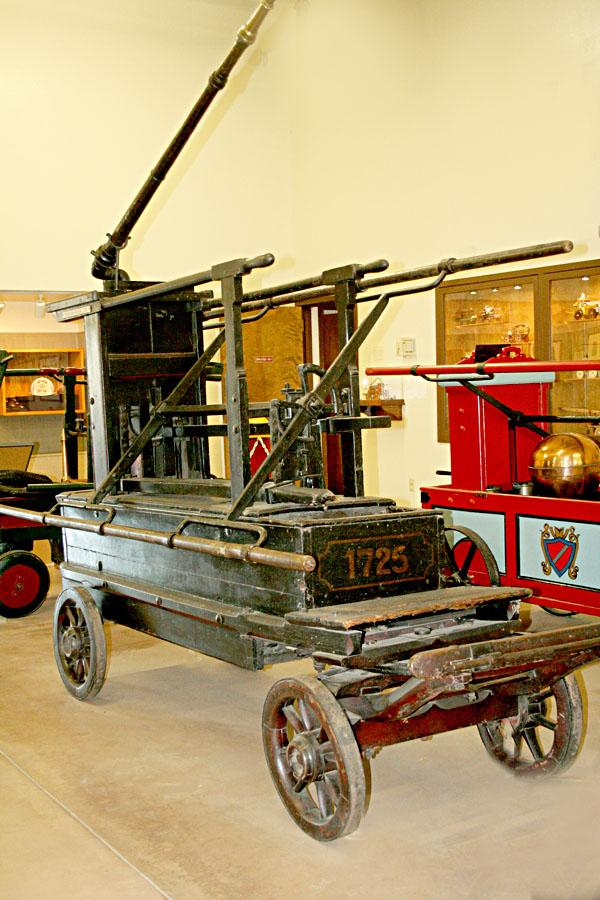After the first structures had been erected in Halifax, two fire engines were unloaded from Edward Cornwallis’ ship, the Sphynx, the care of which was given to the military.
It currently remains an educated guess but there is a strong possibility that these hand tubs, being of British history, were most likely Newsham designed pumpers.
Richard Newsham pumper history:
The first patent for a fire-extinguishing machine was already granted in 1625, but it was not until the early 18th Century that the design was developed as a truly effective manual fire engine. Richard Newsham patented this new design in 1725 and although there were many other manufacturers of fire engines, his designs were the most popular.
The increase in production of manual fire engines in the 18th Century was mainly due to the introduction of the Parish Pumpers act of 1707, which stated that, "every parish was to have and keep in good repair a large engine." A fine could be incurred by the churchwardens if the engine was in disrepair, whilst a reward could be gained for arriving first at a fire".
Early Newsham fire pumps were little more than open troughs with hand-powered pumps on wheels. The trough was filled with water using buckets. Inside the trough were two pistons attached to two large handles. Pumping the handles up and down squeezed the pistons and pushed the water out of a swivelling copper spout on top of the pump. The key element of Newsham's design was a 'gimble' - a chain mechanism that allowed the pistons to remain vertical while pumping. This made the pump far more powerful than other designs.
In 1720 a manual pump was constructed by Richard Newsham that could pump 400 litres per minute, in a continuous stream at flames over 40 metres away!
Richard Newsham patented his "new water engine for the quenching and extinguishing of fiers" in 1721 and went on to design further fire fighting equipment prior to his death in 1743.
Settlement of Halifax Expenditure of 1749:
The following account of the expenditure on the settlement for the year 1749, was submitted to Parliament by the Lords Commissioners of Trade and Plantations:
| (Signed) Christopher Kilby. | |||
| Blankets, Woolens and Shoes for the settlers, and presents for the Indians | £ 1,325 | 4 | 8 |
| Lines, Nets and Hooks for Fishery, Stationery, Surveyors' Instruments, Bricks and Garden Seeds | 2,729 | 12 | 9 |
| Lighterage and Shipping of the settlers, package and charges of Hospital Stores, a Surgeon with medicines by the Transport from Liverpool, and the Union Snow | 336 | 0 | 3 |
| Medicines, Sugar, Live Stock, for the voyage, and Drugs, Instruments and necessaries for the Hospital | 680 | 14 | 8 |
| French Bibles | 102 | 17 | 10 |
| Cash paid for victualling for settlers | 12,068 | 5 | 6 |
| Treasurer of the Navy's account for Bedding and Victualling during voyage | 7,354 | 19 | 0 |
| Ditto, on account of the Sarah, Transport, from Liverpool | 67 | 18 | 8 |
| Treasurer of the Ordnance account for field pieces, swivel guns, small arms and powder | 3,592 | 4 | 4 |
| Printing and incidental expenses by directions of Lords Commissioners of Trade | 445 | 19 | 10 |
| Ventilators for six Transports | 102 | 11 | 6 |
| 2 Fire Engines | 72 | 16 | 0 |
| Pay of Surgeons, Apothecaries, Midwife, exclusive of what they received at Halifax | 860 | 0 | 0 |
| Silver and Gold carried out by the Governor | 3,922 | 8 | 0 |
| Bills of Exchange drawn by the Governor, the account of the expenditure not yet received | 11,452 | 13 | 4 |
| Bills to Capt. Ives for a boat | 40 | 0 | 0 |
| The Treasurer for Scales and Weights | 21 | 7 | 0 |
| Bills drawn by Delancey & Watt, of New York, for Silver sent to the Province | 5,523 | 5 | 9 |
| Thomas Handcock, Esq., for Boards, Plank, 2 Schooners, Salt and Money shipped to purchase materials for mills | 1,528 | 15 | 0 |
| Bills drawn by S. Martin, from Boston | 576 | 8 | 6 |
| £52,804 | 2 | 7 | |
| To the Transport Service for conveying the Settlers to Nova Scotia, etc. | 23,672 | 1 | 3 |
| £76,476 | 3 | 10 | |
| To Governor Cornwallis for personal outfit | 500 | 0 | 0 |
| £76,976 | 3 | 10 | |
(Source: The Project Gutenberg EBook of History of Halifax City, by Thomas B. Akins https://www.gutenberg.org/files/38666/38666-h/38666-h.htm)
1725 Newsham designed pumper. Photo Credit: Hall of Flame Museum



